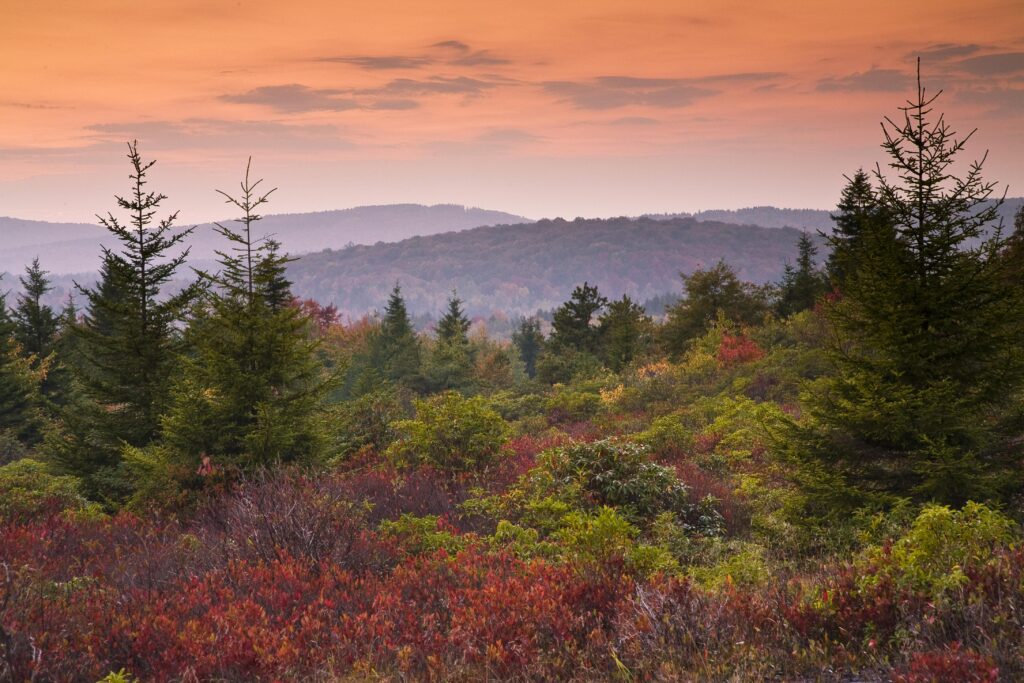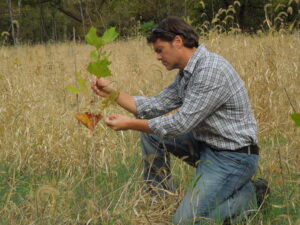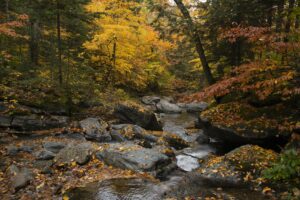by Aliya Uteuova

Fall color in the Dolly Sods Wilderness, part of Monongahela National Forest in West Virginia. “Natural forest regrowth,” a climate-mitigation strategy where forests regrow without human interference, could store 1.6 billion metric tons of carbon annually. (Credit: Kent Mason)
Trees have a powerful ability to absorb carbon dioxide, and a lot of it. According to the Environmental Protection Agency, American forests offset about 12% of the carbon emissions the U.S. creates each year from fossil fuels. While it’s great to plant trees, it can be costly. It’s also important to plant the right species in the right places to avoid disrupting other ecosystems. A major new study published Sept. 23 highlights the potential of an alternate strategy—natural forest regrowth—which can soak up excess carbon and help mitigate climate change.

Susan Cook-Patton, a forest restoration scientist with The Nature Conservancy and former SERC postdoc (Credit: Peter Ellis)
“It is possible to tackle climate change by using every tool in the toolbox, and natural forest regrowth is a powerful one,” said Susan Cook-Patton, lead author from The Nature Conservancy and a former postdoc at the Smithsonian Environmental Research Center. “Although nature can be about a third of the solution, it currently gets about 10% of climate investments. Natural forest regrowth is an underappreciated solution with the potential to capture very large amounts of carbon from the atmosphere.”
Natural forest regrowth involves letting a forest regrow without human action to help, other than eliminating factors disturbing it in the first place, like grazing cows. According to the new study, with the right policies and protections, natural forest regrowth could store 1.6 billion metric tonnes of carbon annually. That’s the equivalent of taking over a billion cars off the road for a year. Led by scientists from The Nature Conservancy and World Resources Institute, the study mapped areas around the world that could bring the highest carbon returns from letting forests regrow for at least 30 years.
The paper, published in Nature, combines results from 256 existing studies. It contains more than 13,000 field measurements from 43 countries. A total of 20 organizations joined forces on the paper, including scientists from the Smithsonian Environmental Research Center and the Smithsonian Tropical Research Institute.
“We are honing in on how much carbon you could take out of the atmosphere with a nature-based climate solution,” said John Parker, an ecologist with the Smithsonian Environmental Research Center.

John Parker examines a sycamore sapling in BiodiversiTREE, a forest restoration experiment he created at the Smithsonian Environmental Research Center. (Credit: Kristen Minogue/SERC)
Prior to this study, good estimates of carbon capture from natural forest regrowth were not easy to locate. Researchers also would often apply a single number to all of the tropics, creating room for over- or underestimation. In fact, the study suggests that the United Nations Intergovernmental Panel on Climate Change (IPCC) may have underestimated aboveground carbon accumulation rates in young forests by a full 32%.
“Previous data on global natural forest regrowth wasn’t pulled from a specific country,” Parker said. “With tens of thousands of data points, this paper is a rigorous assessment of where and how effective it would be to let forests regrow.”
The improved spatial resolution in the study would allow scientists and policymakers to better identify areas with the highest potential to store carbon.
While planting trees will be necessary in some places, Cook-Patton said it can also be expensive and time-consuming. It also can take a lot of labor to generate enough trees and care for them. She recommended that people always ask first: If the conditions are right, can we simply let the forest regrow?
She also emphasized new forests are not a substitute for intact forests.

Intact and healthy forests, like this one in Burnt Mountain, Vermont, remove pollutants, clear the air, improve water quality and slow climate change through carbon sequestration.
(Credit: Eamon Mac Mahon)
“It is usually much better to protect existing forests. You can’t cut down forests in one part of the landscape and expect to get the carbon back by regrowing forests in another,” she said. “The main point of the paper is to give a sense of how much carbon you can give to a patch of land that used to be a forest.”
Despite the map’s high resolution, almost all the data came from 10 countries in North America, South America and Europe. Co-author Kristina Anderson-Teixeira’s lab has created and maintains the Global Forest Carbon database — the most comprehensive database of forest carbon stocks worldwide. The data from this new study now lives in the carbon database. As new numbers in different countries become available, scientists can add new field points.
“I can say we have the highest uncertainty in North Africa and Northeast Asia, because of lack of data,” Cook-Patton said. “The quality of our map depends on data quality and availability, and we have made it easy for our map to be continuously improved as new data become available.”
In the search for climate change solutions, advanced technology often gets the most attention. But there’s a case for reducing the carbon footprint by working with nature and using low-tech solutions. Allowing forests to grow back naturally is one of them.

